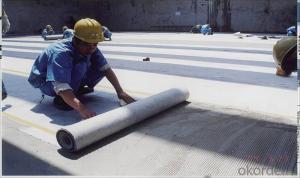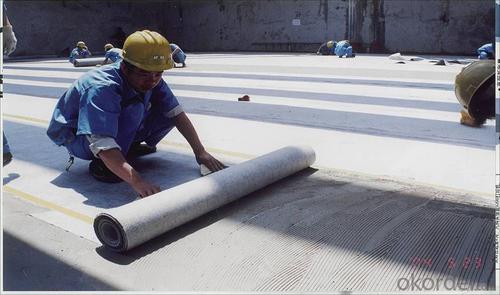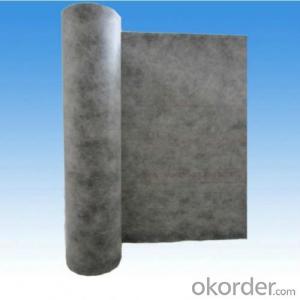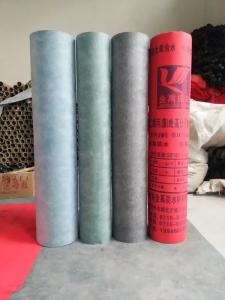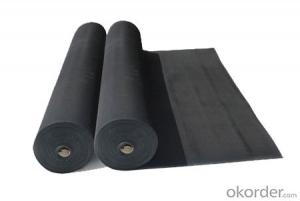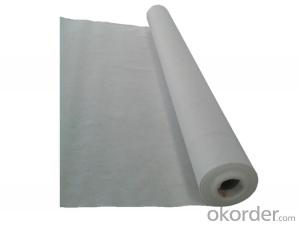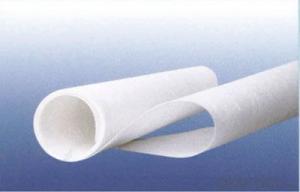High Polymer Polyethylene Waterproof Membrane
- Loading Port:
- China Main Port
- Payment Terms:
- TT OR LC
- Min Order Qty:
- -
- Supply Capability:
- -
OKorder Service Pledge
OKorder Financial Service
You Might Also Like
This product is composed of extruded PE membrane with polypropylene fiber or dacron and self-adhesive covered on both sides of the core membrane as reinforced layer to make it big friction and easy to be stuck firmly to the concrete. With characteristics of easy installation, no pollution and good durability.
Polyethylene polymer waterproofing materials performance index
GB 18173.1-2006
Items | FS2 Resins | Applicable Test Category | |
Tensile Strength(N/cm) | Normal temperature≥ | 60 | GB6.3.2 |
60°C≥ | 30 | ||
Elongation% | Normal temperature≥ | 400 | |
-20°C | 10 | ||
Tear Strength ( N) | ≥ | 20 | GB6.3.3 |
(0.3Mpa.30 min)Water impermeability | No leakage | GB6.3.4 | |
- Q: Can a waterproofing membrane be repaired if damaged?
- Yes, a waterproofing membrane can be repaired if damaged. The extent of the damage will determine the repair method and whether it can be fixed on-site or if a professional needs to be called in. Small punctures or tears in the membrane can often be patched with a sealant or adhesive, while larger or more severe damage may require a section of the membrane to be replaced. It is important to address any damage promptly to prevent further water penetration and potential structural issues.
- Q: Can a waterproofing membrane be used on stucco surfaces?
- Yes, a waterproofing membrane can be used on stucco surfaces. Waterproofing membranes are often applied to stucco surfaces to protect them from water damage and enhance their durability. These membranes create a barrier that prevents water from seeping into the stucco, helping to maintain its integrity and preventing moisture-related issues such as cracking or mold growth.
- Q: Can a waterproofing membrane be used for hotels or resorts?
- Certainly, hotels or resorts can utilize waterproofing membranes. These membranes are widely employed in the construction sector to safeguard different structures against water damage, which includes hotels and resorts. Their objective is to create a barrier that hinders water infiltration, effectively averting leakages and moisture-related concerns. To ensure lasting protection, these membranes can be expertly applied to various areas within a hotel or resort, such as roofs, basements, bathrooms, swimming pools, and balconies. The implementation of a waterproofing membrane in these establishments is crucial to uphold structural integrity, forestall water damage, and offer guests a comfortable and secure environment.
- Q: Can waterproofing membranes be used for planter boxes?
- Yes, waterproofing membranes can be used for planter boxes. Waterproofing membranes are designed to prevent water from penetrating surfaces, and can be applied to various materials such as wood, concrete, or metal. By applying a waterproofing membrane to the inside of a planter box, it can help to protect the material from water damage, prolonging the lifespan of the planter box. This is especially beneficial for wooden planter boxes, as the membrane can prevent the wood from rotting or deteriorating over time. Additionally, the waterproofing membrane can help to retain moisture within the planter box, preventing water from seeping out and ensuring that the plants receive sufficient water for healthy growth. Overall, using waterproofing membranes for planter boxes can help to improve their durability and performance, making them a popular choice for both indoor and outdoor gardening.
- Q: Can a waterproofing membrane be used for a basement wall?
- Yes, a waterproofing membrane can be used for a basement wall. Waterproofing membranes are effective in preventing water penetration and can help to keep the basement dry by creating a barrier against moisture.
- Q: Can a waterproofing membrane be used for a school?
- Yes, a waterproofing membrane can be used for a school. Waterproofing membranes are commonly used in various construction projects, including schools, to protect the building and its occupants from water damage. These membranes are typically applied to areas such as basements, roofs, and foundation walls to prevent water infiltration. By creating a barrier against moisture, a waterproofing membrane helps to maintain a dry and safe environment within the school, protecting against potential structural damage, mold growth, and other water-related issues. Additionally, waterproofing membranes often come with additional benefits such as insulation and soundproofing, which can contribute to a comfortable and conducive learning environment for students and staff.
- Q: Can a waterproofing membrane be used on aerated concrete block surfaces?
- Yes, a waterproofing membrane can be used on aerated concrete block surfaces. The membrane helps to prevent water penetration, protecting the aerated concrete blocks from moisture damage and increasing their longevity.
- Q: Does a waterproofing membrane require any specific surface preparation?
- Yes, a waterproofing membrane typically requires specific surface preparation before installation. This involves cleaning the surface, removing any loose debris, and ensuring it is smooth and dry. Additionally, some membranes may require priming or the use of specific adhesives depending on the type of surface they are being applied to. Proper surface preparation is crucial to ensure effective adhesion and long-lasting waterproofing performance.
- Q: Can a waterproofing membrane be used for historical buildings?
- Yes, a waterproofing membrane can be used for historical buildings. However, it is important to consider the specific requirements and characteristics of the building. Some historical buildings may have unique architectural features or materials that need to be preserved, so it is crucial to choose a waterproofing membrane that is compatible with the building's structure and aesthetics. Additionally, consulting with preservation experts and following proper guidelines is essential to ensure the long-term protection and conservation of the historical building.
- Q: Does a waterproofing membrane require any specific primers or bonding agents for installation?
- Yes, a waterproofing membrane typically requires specific primers or bonding agents for proper installation. These primers or bonding agents are necessary to ensure proper adhesion and create a strong bond between the membrane and the substrate, enhancing the effectiveness and longevity of the waterproofing system.
Send your message to us
High Polymer Polyethylene Waterproof Membrane
- Loading Port:
- China Main Port
- Payment Terms:
- TT OR LC
- Min Order Qty:
- -
- Supply Capability:
- -
OKorder Service Pledge
OKorder Financial Service
Similar products
Hot products
Hot Searches
Related keywords
